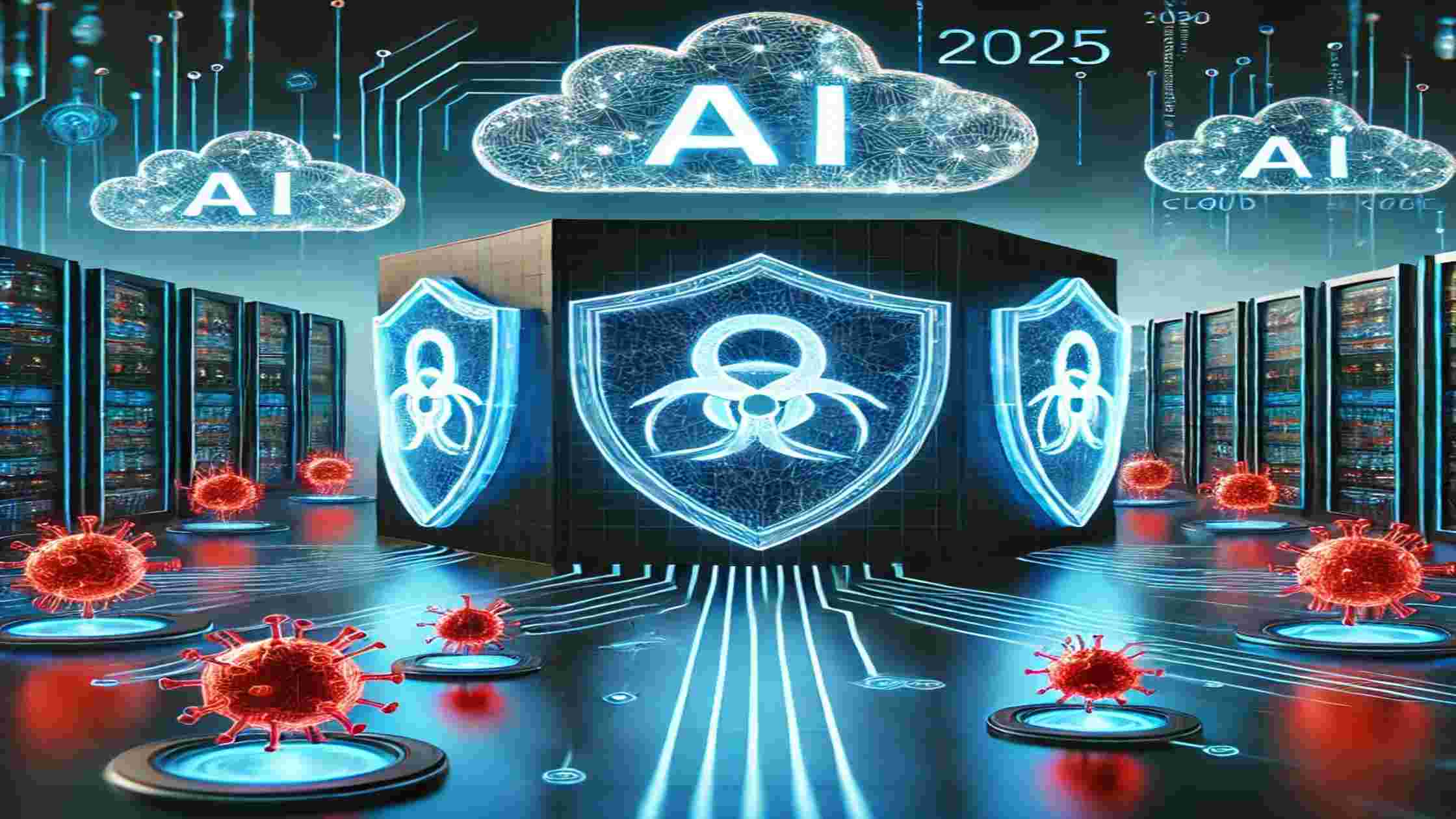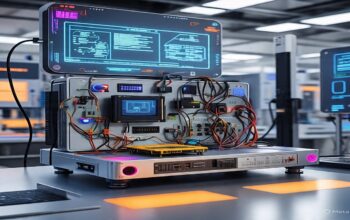INTRODUCTION
As businesses increasingly adopt cloud and edge computing technologies, the cybersecurity landscape faces previously unheard-of difficulties. To combat sophisticated, AI-driven threats, cyber defense systems must integrate artificial intelligence (AI) by 2025. This article explores new risks, discusses how AI is revolutionizing cybersecurity, and provides practical advice for companies trying to safeguard their digital infrastructure.
Covered Contents
ToggleThe Development of Cyberthreats Driven by AI
AI is being used by cybercriminals to launch highly targeted and evasive attacks. The most noteworthy advancements are:
AI-Generated Social Engineering:
Phishing emails and texts that are indistinguishable from regular correspondence are produced by advanced generative AI algorithms.
Autonomous Malware:
Adaptive malware that changes its code in real time to learn how to avoid traditional detection methods.
Exploitation of Synthetic Media:
Deepfakes are being utilized to pose as executives to approve fictitious transactions or private data.
Significance:
According to IBM’s 2024 Cybersecurity Report, AI-based assaults have increased breach costs by 43% and reduced detection times by 80%.
Strategic Defense Mechanisms: AI in Cloud and Edge Security
1-AI-based Threat Detection within Cloud Environments
Cloud environments today process petabytes of data daily, and AI-driven monitoring is a must. Products like Amazon Web Services (AWS) GuardDuty AI use machine learning to:
–Identify geographically suspicious login activity.
–Detect unauthorized data exfiltration activities.
–Detect Flag ransomware encryption in real-time.
Case Study:
In Q3 2024, Microsoft Azure’s AI security portfolio prevented a ransomware attack on a global healthcare provider by isolating infected nodes in 1.8 seconds without losing data.
2-Protecting Edge Computing Infrastructure
Gartner predicts that 75% of business data will be sourced from edge devices by 2025. To counter IoT and edge network threats, firms like Cisco and Palo Alto Networks employ embedded AI chips that:
–Implement strict access controls using biometric authentication.
–Preprocess and encrypt data locally before transmitting.
–Use automated patch management to address zero-day exploits.
Industry Insight:
Tesla’s AI edge framework now proactively blocks unwanted firmware updates to preserve autonomous driving system integrity.
3-Zero Trust Architecture Powered by AI
The use of AI for dynamic risk-based assessments complements Zero Trust architecture, which requires real-time authentication for both users and machines at all times. Methods like Darktrace’s Antigena use unsupervised learning to:
–Create baselines for user and device behavior.
–Apply adaptive access policies based on current risk scores.
–Automatically quarantine compromised endpoints
Data Point:
According to Forrester’s 2024 Security Survey, businesses that implemented AI-secured Zero Trust architectures saw a 62% annual decrease in breach occurrences.
4-Mitigating AI-Driven Ransomware
These days, ransomware organizations use AI to speed up encryption and target important assets. On the other hand, cybersecurity behemoths like SentinelOne and CrowdStrike have created AI tools that:
–Examine past attack trends to forecast ransomware activity.
–Launch honeypot decoys to deceive attackers.
–Synchronize immutable backup restore processes.
Best Practice:
The National Institute of Standards and Technology (NIST) recommends using AI-based detection in conjunction with air-gapped backups to improve resilience.
Synergizing Human Expertise with AI
AI augments—rather than replaces—human analysts by automating routine processes and increasing decision-making. For example:
Natural Language Processing (NLP):
From unstructured threat alerts, programs such as OpenAI’s GPT-5 create incident response playbooks.
Predictive analytics:
IBM Watson forecasts regional assault trends by correlating global threat data.
Expert View: “AI manages scalability; humans add contextual judgment,” says Dr. Jane Hollis, Director of MIT’s Cybersecurity Initiative.
New Dangers and Strategic Issues for 2025
Adversarial AI: Neural network training by attackers to get around defensive AI models.
Supply Chain Weaknesses: Breaching business clouds by compromising third-party suppliers (e.g., SolarWinds 2020).
Hazards of Quantum Computing: Although post-quantum cryptography, AI solutions are being developed, legacy systems may be decrypted.
Strategic Recommendations for Enterprise Security
Integrate Next-Generation AI Solutions: To enable real-time threat intelligence and active protection strategies, implement AI-powered solutions like Sophos Intercept X and Fortinet FortiAI. Sophos Intercept X uses deep learning to stop and identify known and unexpected threats like ransomware, malware, and phishing scams. Fortinet’s FortiAI quickly identifies and fixes network vulnerabilities to prevent potential breaches.
Perform Extensive AI Red-Teaming Drills: Periodically run AI-driven simulations of attacks to extensively test and strengthen your security posture. AI red-teaming exposes weaknesses by simulating adversarial methods, reinforcing defenses and revealing vulnerabilities before they can be exploited.
Invest in Training for Advanced Workers: Prepare your security staff to examine AI-generated alerts and respond to emerging risks like deepfakes. Developing strong analytical skills is essential for identifying AI-driven anomalies and responding effectively to advanced threats.
Collaborative Defense Program Participation: To establish a cooperative cybersecurity defense program, participate in threat-sharing programs like the Cyber Threat Alliance (CTA). By exchanging threat intelligence, these partnerships help firms stay ahead of changing threats and improve defenses together.
The Future of AI in Cybersecurity: Beyond 2025
By 2030, AI will revolutionize cybersecurity with sophisticated capabilities. It will forecast cyberattacks based on behavior patterns, enabling proactive threat prevention. Networks will be self-healing, detecting and repairing breaches automatically without human intervention. Moreover, frameworks will be established to make AI-based security decisions transparent and ethical, focusing on fairness and accountability.
Key Considerations for Stakeholders
Q: How can small and medium-sized businesses (SMEs) implement AI security affordably?
A: Cloud-based AI solutions such as Microsoft Defender for Cloud provide scaling pricing plans, with entry-level options below $75/month.
Q: Will artificial intelligence reduce the need for cybersecurity experts?
A: Due to the complexity of AI and regulatory constraints, the U.S. Bureau of Labor Statistics predicts that employment in cybersecurity will increase by 35% by 2025.
Q: What moral ramifications might artificial intelligence have for cyber defense?
A: To avoid biases and ensure accountability, organizations must make sure that AI implementations comply with regulations like the EU’s AI Act.
Conclusion
As cyber threats leverage AI, businesses need to embrace equally advanced defenses to secure cloud and edge environments. By embedding AI in Zero Trust architectures, investing in workforce training, and encouraging cross-industry collaboration, organizations can safely navigate the 2025 threat environment. As Jen Easterly, Director of CISA, states: “Proactive AI adoption is no longer optional—it is a strategic imperative.”



2 thoughts on “AI vs Cyberattacks: 2025 Cloud & Edge Defense”